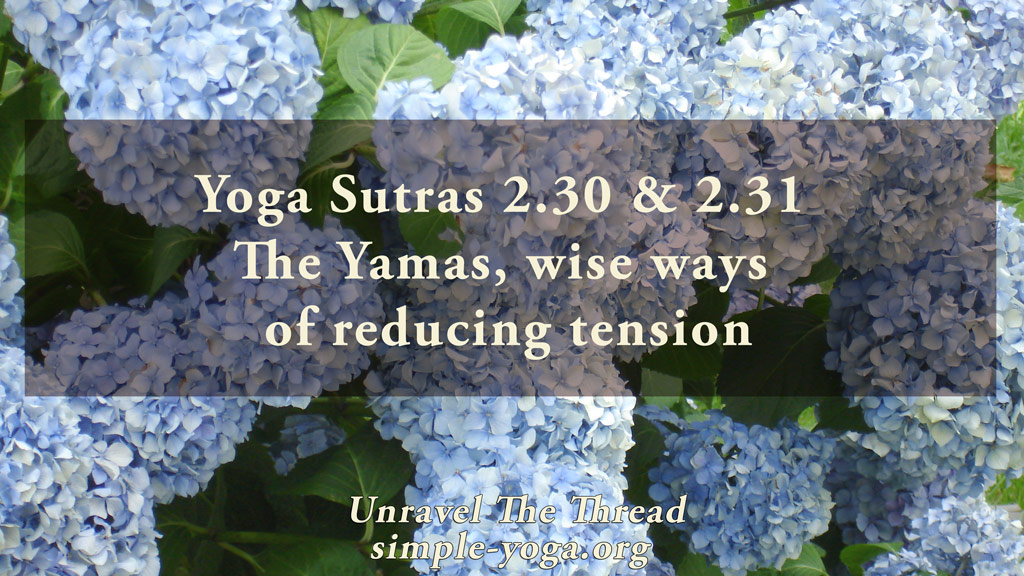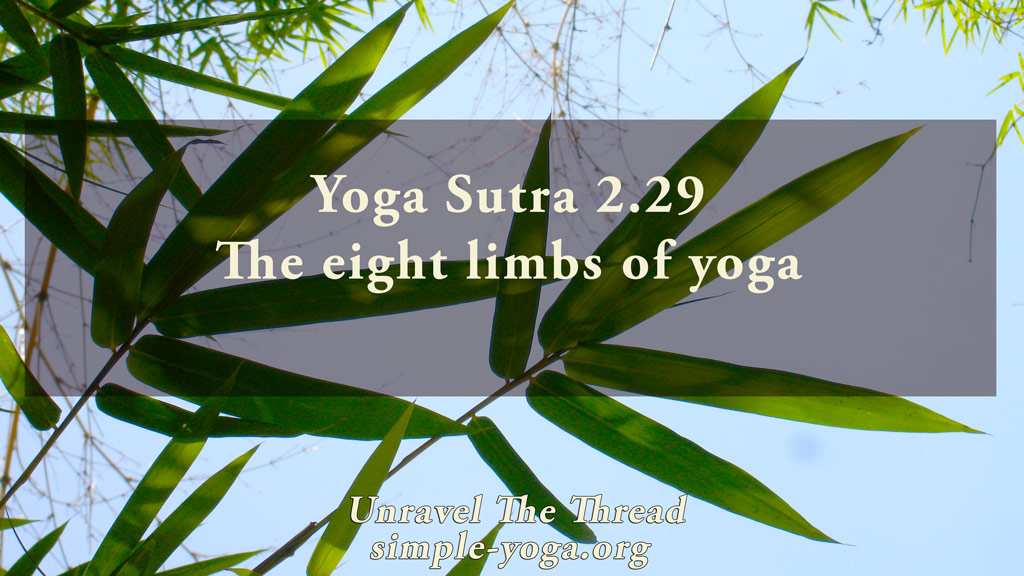
2.28 Effects of practicing the eight limbs of yoga
September 6, 2020
2.30 & 2.31 The Yamas, wise ways for removing strain
September 12, 2020
2.28 Effects of practicing the eight limbs of yoga
September 6, 2020
2.30 & 2.31 The Yamas, wise ways for removing strain
September 12, 20202.29 The eight limbs of yoga

2.29 The eight limbs of yoga are: opening your mind (yama), opening your heart (niyama), optimizing body function (asana), enhancing vital energy flow (pranayama), clarifying the senses (pratyahara), focusing the mind (dharana), effortless awareness (dhyana) and integration (samadhi)
The eight limbs (ashtanga) of yoga present a comprehensive set of practices to bring about integration and harmony within yourself. This inner integration fosters greater harmony between you and the world around you. The yamas are wise ways of being that remove strain and cultivate harmony to open your mind. The niyamas are helpful attitudes to remove struggle and cultivate balance through opening your heart. Asana are practices that optimize body function through postures, movements and awareness of interconnectedness among body systems. Asana results in embodied joyful equilibrium. Pranayama enhances vital energy flow throughout your body. It is cultivated by developing intimacy with your breathing processes. Pratyahara consists of practices that direct your attention inwardly, clarifying the senses and developing inner sensitivity. Dharana concentrates the mind and heart. Dhyana (meditation) practices promote effortless expansion of inner stillness and silence. Samadhi is the gradual and natural progression from dhyana. Samadhi happens when you set aside your opinions and inner chatter so that you are fully integrated into pure awareness rather than gravitating towards your thoughts, opinions and beliefs.
In present times, the words yoga and asana have become virtually interchangeable. However, in Patañjali’s perspective, yoga consists of a complete system for enhancing the quality of life for the practitioner. While some approaches to yoga see these eight components of yoga as a succession moving from yama towards samadhi, other approaches begin with meditation. Yet other practitioners see the physical practice of asana as the most accessible starting point. For most of us, mastering even one single branch can be a challenging and long journey. Thus, a better approach may be to cultivate all aspects of yoga to the extent that is possible for each practitioner. Since each set of practices addresses different, yet interrelated, aspects of your being, it is intelligent to combine the various limbs in order to develop a balanced, integrative and synergistic practice.
As you have seen in other parts of the Yoga Sutra, a key aspect of yoga is self-regulation. Part of the self-regulation process is to be well-aware of your tendencies. As a result, you can avoid an inclination to practice that which you are already good at, or that which exacerbates the tendencies pulling you away from balance. You can ask yourself, what does your practice consist of? Which limbs of yoga do you prefer to practice? Why? Use sutras 2.1 and 2.2 (definition of yogic action and its results) as well as sutra 2.28 (effects of the practice) to guide your practice by asking: Am I practicing with enthusiasm, intelligence and humility (2.1)? Is my practice creating increased harmony, integration and greater inner peace (2.2 & 2.28)? Other useful questions include: Does your current practice create a balance between body, mind and emotions? How is your practice contributing to the quality of your participation in your life? How does your practice influence the overall quality of your life?
As usual, one more way of exploring the meaning of this sutra is by chanting it.
You can choose to chant it in its traditional form with some of the words coming together:
2.29 yama niyamāsana prāṇāyāma pratyāhāra dhāraṇā dhyāna samādhayo’ṣṭāvaṅgāni
यम नियमासन प्राणायाम प्रत्याहार धारणा ध्यान समाधयोऽष्टावङ्गानि ॥२९॥
Another option is to chant each word in the sutra individually:
- yama
- niyama
- asana
- prāṇāyāma
- pratyāhāra
- dhāraṇā
- dhyāna
- samādhayaḥ
- aṣṭāu
- aṅgāni
If you prefer, you may listen to the podcast:
Unravel the thread is now available as a book!
If you find Simple-Yoga.org and Unravel the thread useful, consider supporting my labor with a donation, you may also donate using PayPal or Venmo. Thank you!
